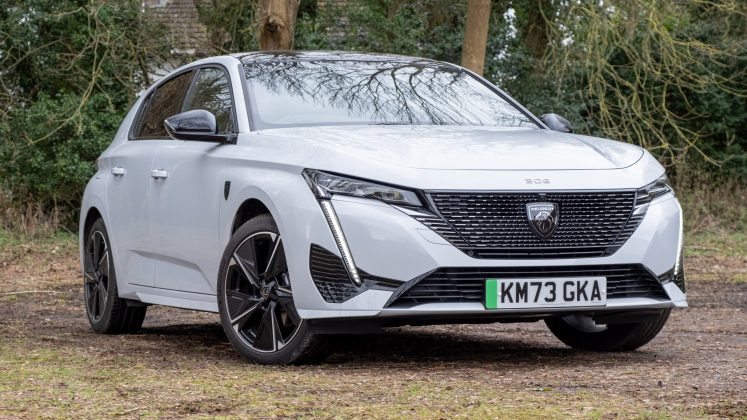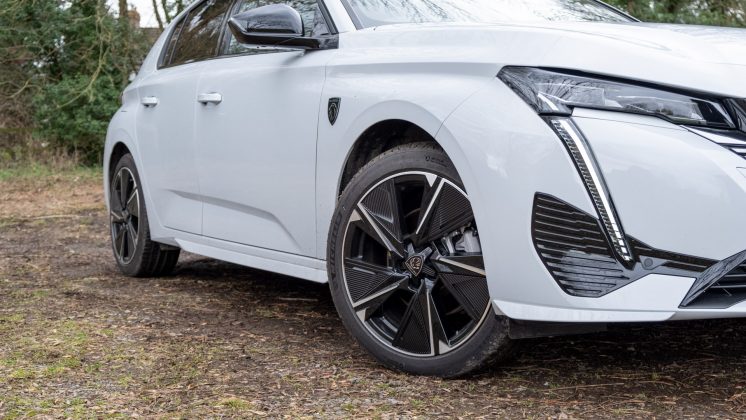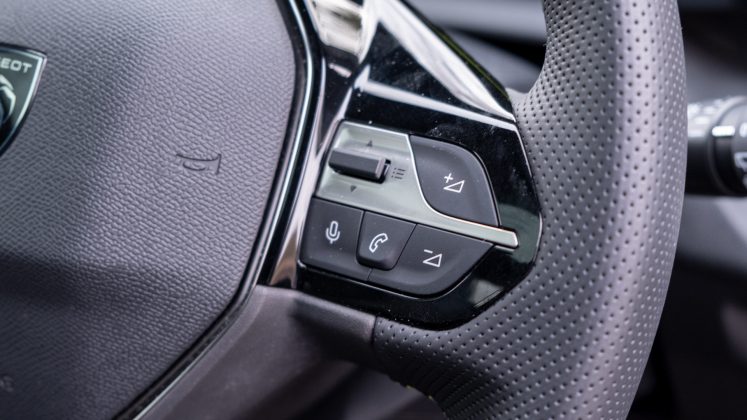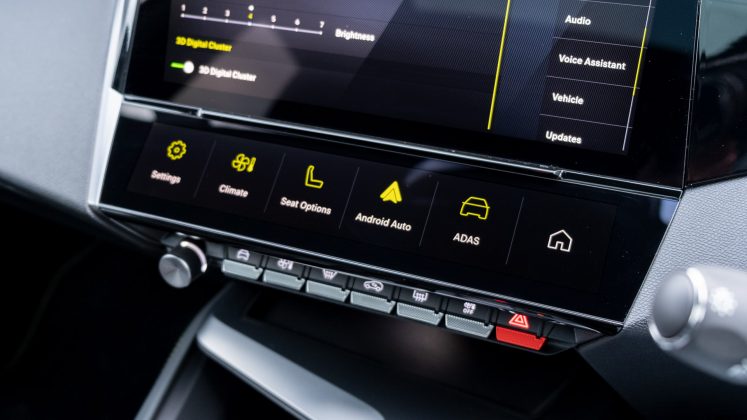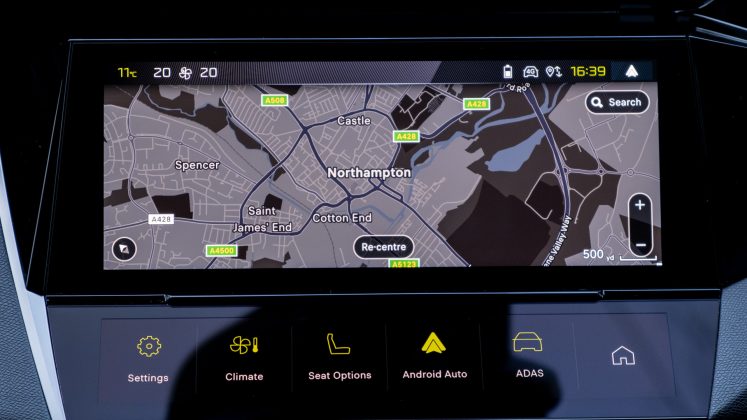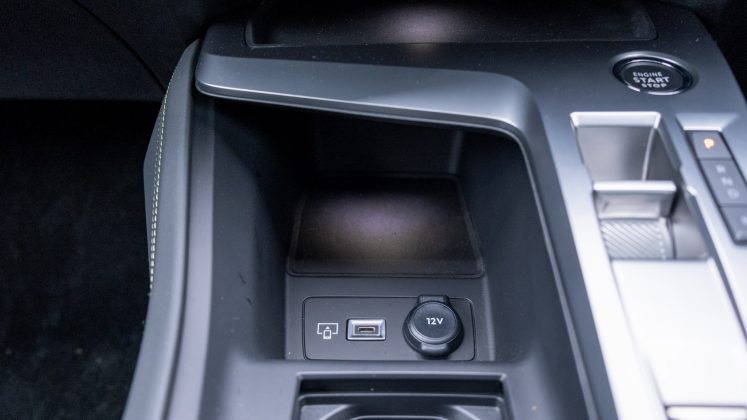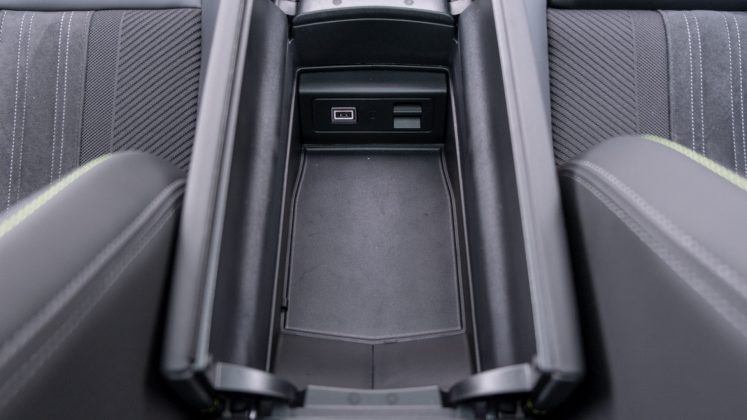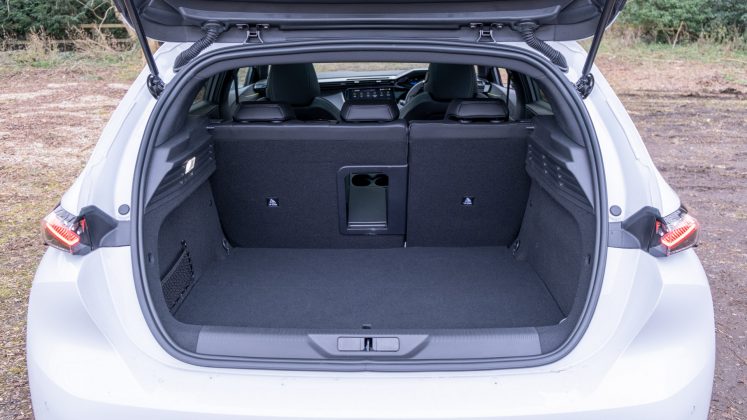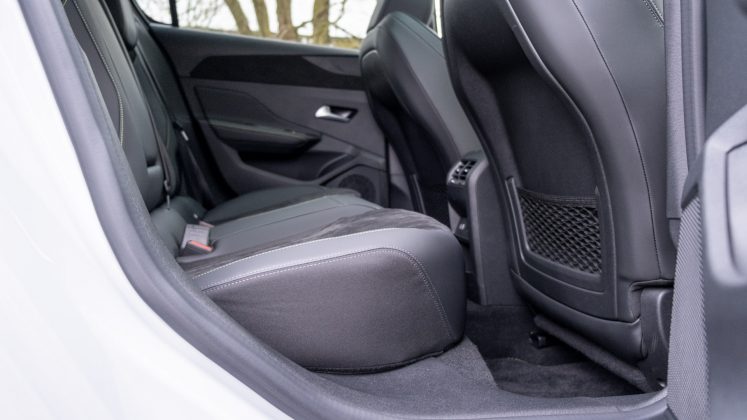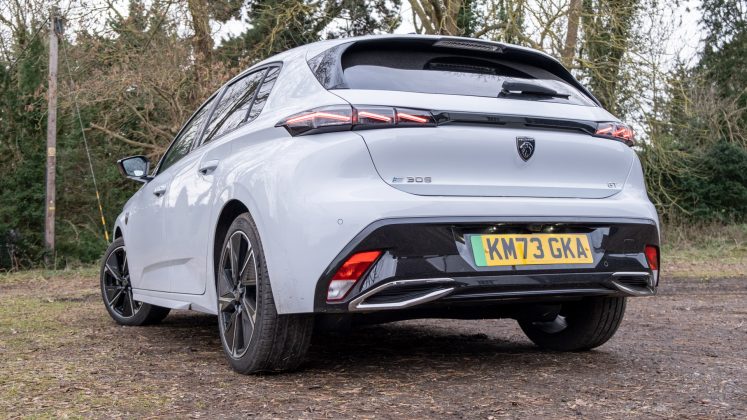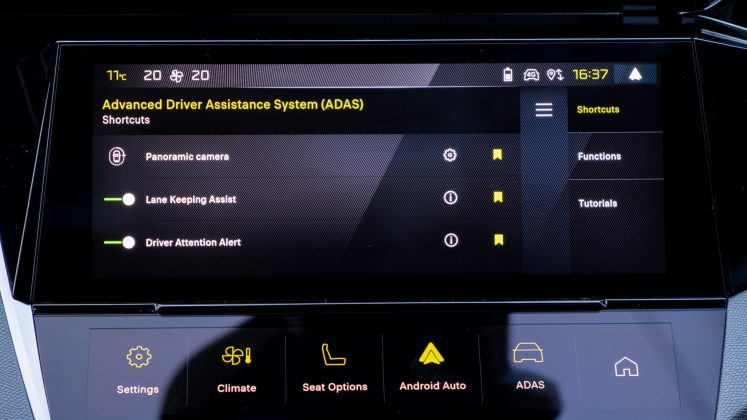The Peugeot 308 has been around since 2007 as a petrol, diesel and plug-in hybrid, but for the first time, it’s also available as a fully electric vehicle. It bridges the gap between the smaller e-208 hatchback and the 508 saloon, while also attempting to compete with the likes of Tesla, Volkswagen, Cupra, Polestar, MG, BYD, Hyundai and other vehicles from the Stellantis Group, such as Vauxhall, Citroen and even Jeep.
If you’d prefer to watch a review of the Peugeot e-308, head on over to our YouTube channel.
Peugeot e-308 price & competition
Unlike many of its rivals, the e-308 is also available as an estate, which is a rarity in the EV space. Indeed, there’s the e-308 and e-308 SW to choose from – they’re near-identical, with the biggest differentiator being the asking price: the regular hatchback starts from £40,050 for the Allure and rises up to £42,120 for the GT that we have on review, while the estate starts from £41,250 and goes up to £43,320 without adding any additional options.
A breakdown of the differences between the trims can be found below (click to expand):
Find the best Peugeot e-308 deals
In terms of the alternatives, there are quite a few hatchbacks and saloons to consider, especially considering the base price of the e-308: the MG4 EV from £26,995; Fiat 500 Electric from £28,195; Nissan Leaf from £28,495; Mini Electric from £31,550; Renault Zoe from £31,195; Smart #1 from £31,950; GWM Ora 03 from £31,995; Peugeot e-208 from £32,650; Vauxhall Corsa-e from £33,730; MG4 EV XPower from £36,495; Cupra Born from £36,475; VW ID.3 from £37,255; Tesla Model 3 from £39,990; Polestar 2 from £44,950; BYD Seal from £45,695; Hyundai Ioniq 6 from £47,040; and the BMW i4 from £50,755.
There are also a few compact SUVs you might want to consider, such as: the Fiat 600e from £29,995; MG ZS EV from £30,495; Citroen e-C4 from £30,569; Citroen e-C4 X from £31,610; Kia Soul EV from £32,875; Hyundai Kona Electric from £34,995; Jeep Avenger from £35,700; Peugeot e-2008 from £36,500; Kia Niro EV ‘2 64’ from £37,325; Vauxhall Mokka-e from £37,610; Skoda Enyaq iV from £40,585; Volkswagen ID.4 from £42,640; Hyundai Ioniq 5 from £43,445; BMW iX1 from £44,560; Tesla Model Y from £44,990; Kia EV6 from £45,275; and the Audi Q4 40 e-tron from £50,745. You’ve also got the MG5 EV, an all-electric estate that starts from £30,995, and the Smart #1, a crossover that starts from £31,950.
Read next: Kia Niro EV review: An upgraded e-Niro?
Peugeot e-308 exterior review
From the exterior, the e-308 has an eye-catching design. The stylish grille gives it a modern twist and its headlights a somewhat aggressive stance. From the side, you’ll find alluring 18” alloys that come as standard, body-coloured wheel arches and flared side skirts. Towards the rear, the taillights and the integrated spoiler give it that sporty flair.
In terms of your colour options, the hatchback comes in Olivine Green, while the estate is in Avatar Blue, which is refreshing. Should you want the metallic Cumulus Grey, Nera Black, Selenium Grey, Obsession Blue (hatchback only) or the pictured Okenite White you’ll have to splash out an extra £650. The premium metallic Elixir Red will set you back an additional £850 instead.
Read next: New Tesla Model 3 review: The highland upgrade or downgrade?
Peugeot e-308 interior review
Inside, the cabin is still exquisitely designed; from the stitching work on the upholstery, the materials used on the dashboard to the finish of the door frames. Granted, it won’t compete with more premium alternatives, but it still looks and feels the part.
Better still, Peugeot has retained a practical interior design, with a flurry of physical buttons on the steering wheel, the centre console and the dashboard; there are a few physical shortcuts that give you quick access to certain key settings, such as the climate controls. It’s also fantastic that there’s a small customisable touchscreen panel that resides just under the centre display. These customisable Virtual i-Toggles allow for shortcuts to certain menus and options on the infotainment system. Great thinking by the manufacturer.
As for the infotainment system, there is a responsive and vivid 10” touchscreen display, which is slightly angled towards the driver making it easier to use. However, it’s not that intuitive to navigate as Peugeot’s settings are a little convoluted. Equally, the transitions between menus and settings take a bit longer than they should – hopefully, Peugeot can address this in a future firmware update.
On that note, it’s great to see that both Android Auto and Apple CarPlay are supported over a wired and wireless connection; the latter makes it even easier to connect a smartphone to the infotainment system.
With that said, the level of integration stops at the centre display, as turn-based navigation data isn’t fed through to the fully digitalized 10″ instrument cluster. A real shame as some of its competitors provide said feature. Equally, there’s no Head-Up Display (HUD), be it as standard in the GT trim or available as an option.
Instead, Peugeot has decided to double down on the driver’s display by providing a good degree of customisation and a 3D design, which is present only in the top-spec GT trim. Indeed, via the infotainment system, you can toggle between a 2D or a 3D look. The former is the more practical out of the two, while the latter provides more depth to the speedometer and power gauge.
Regarding its audio system, there’s a six-speaker system that comes fitted as standard on all the trim levels. Unlike the petrol-powered 308, the electric model can’t be fitted with the optional Focal system, which is quite disheartening for budding audiophiles. If you’d like to hear how the system performs, watch our detailed review on YouTube.
Peugeot e-308 storage review
Aside from its stylish and tech-centric interior, the Peugeot e-308 is also very practical with its flurry of storage compartments. At the front, there’s a non-slip area, which in the GT trim doubles up as a wireless phone charger. This, however, will cost you an additional £100 – quite cheeky from the manufacturer, given the vehicle’s asking price. Thankfully, just below, you’ll find another non-slip area, a 12V socket and a USB-C port fitted as standard across the trim range; the latter port can be used to connect to the infotainment system and provide charge.
Further down the centre console, there are two cupholders, a space to store your key fob and a larger storage area within the centre armrest. Here, you’ll also find a USB Type-C port for charging, while at the rear there are a further two for your passengers.
As for the glove box, it’s relatively compact but the front door bins, which have been lined in fabric, are large enough to accommodate a 500ml bottle alongside a wallet or purse, while the rear two are a little smaller. Two cupholders can also be revealed by pulling down the rear armrest.
As for its boot capacity, the Peugeot e-308 hatchback offers 361 litres with the seats up and 1,271 litres with them folded flat. The estate offers 548 and 1,574 litres, respectively. Both will suffice for your weekly shops, with the SW model being even more practical for taking elongated goods.
Here’s how it stacks up to its competitors: Audi Q4 e-tron (520/1,490 litres); Citroen e-C4 X (510/1,360 litres); MG ZS EV (448/1,375 litres); Kia Niro EV (475/1,392 litres); Tesla Model 3 (594/1,300 litres); Peugeot e-2008 (434/1,467 litres); BMW i4 (470/1,290 litres); Nissan Leaf (435/1,161 litres); Hyundai Ioniq 6 (401/1,100-1,300); BYD Seal (400/1,100-1,300); Kia Soul EV (315/1,339 litres); VW ID.3/Cupra Born (385/1,267 litres); Citroen e-C4 (380/1,250 litres); Polestar 2 (405/1,095 litres); Renault Zoe (338/1,225 litres); MG4 EV (363/1,177 litres); Hyundai Kona Electric (332/1,114 litres); Smart #1 (421/989 litres); Peugeot e-208 (311/1,106 litres); Vauxhall Mokka-e (310/1,060 litres); Vauxhall Corsa-e (267/1,076 litres); GWM Ora Funky Cat (228/858 litres). As for the MG5 EV estate, it offers 479 and 1,367 litres, respectively.
In terms of practicality, the Peugeot e-308 has a hatchback design, with 60:40 rear-split folding seats with an integrated ski latch (40:20:40 design in the estate), a flat loading bay and a sizable underfloor compartment that’s large enough to accommodate the vehicle’s charging cables. An electric tailgate is available as an option in the SW model only.
Unlike some of its rivals, however, the e-308 doesn’t come with a frunk (a storage area at the front). This is, in part, due to the vehicle not being built from the ground up as an EV.
Reax next: Smart #1 review: The best new EV?
Peugeot e-308 comfort review
Aside from storage, the Peugeot e-308 has comfortable and accommodating seats. They’re not as padded cushiony soft as the ones found in the e-C4 or e-C4 X but they still provide excellent support to both front and rear passengers.
As for headroom and legroom, it’s a non-issue at the front of the cabin. However, the same couldn’t be said at the rear, as space is extremely limited. Headroom is quite tight for 6-foot (182cm) individuals, while legroom is restricted. It’s not aided by the fact that there is a nonsensical transmission tunnel, which eats up space for your rear occupants.
In terms of seat adjustments, the front two are manually-operated only, with lumbar support for the driver fitted as standard. Should you want electric controls and a massage function you’ll have to splash out £500 on the Driver and Passenger Seat pack. Heated front seats come fitted as standard, while a heated steering wheel is only available in the GT trim. Equally, you’ll need to opt for said trim if you want to spend an extra £900 on the glass roof with sun blind.
Find the best Peugeot e-308 deals
What is great to see, however, is the hexagonally-shaped steering wheel. It’s fitted as standard across the trim range and we previously noted its unique form factor in the e-208, e-2008 and 408 Hybrid. Indeed, its compact design makes it easy to grip and entices a degree of connection with the front axle. As for cabin noise, it’s kept down to a minimum thanks to an acoustic-tinted windscreen fitted as standard.
Read next: Citroen e-C4 review: Most comfortable SUV?
Peugeot e-308 performance review
Thanks to its steering wheel and the mechanical optimisations that have been done by the automaker, the e-308 feels engaging to drive. You almost feel at one with the vehicle when cornering at speed on the country roads. Sure enough, it won’t have the utmost sporty feel of the Polestar 2 and BMW i4, but it’s still up there with its competitors.
Equally, its suspension system won’t compete with those that have adaptive setups but it’s still comfortable to drive. It soaks up anomalies, speed bumps and potholes with ease and doesn’t suffer from body lean either. Peugeot has set up the vehicle perfectly.
What isn’t as impressive, however, is that it has a front-wheel drive configuration, which doesn’t provide the utmost confidence when faced with wet tarmac. Many of its rivals provide a rear-wheel or all-wheel drive setup instead, which not only provides better traction but also aids with the driver’s feel.
Speaking of which, the e-308 isn’t punchy to drive, as Peugeot has fitted a single motor on the front axle, meaning it outputs 115 kW of power (156 hp) and 270 Nm of torque. Using Racelogic’s Performance Box Touch we had it tested from 0-20mph in 2.35 seconds, 0-30mph in 3.95 seconds; 0-60mph in a disappointingly slow 9.49 seconds; 50-70mph in 4.4 seconds and a peak acceleration of 0.39g. Top speed is limited to 106mph.
Buy a car phone mount on Amazon (Affiliate)
Despite its lacklustre performance, especially in comparison to some of its competitors, it should still suffice for most. Another contentious topic is its electric range. Peugeot has fitted a 54 kWh battery pack, which is claimed to provide 237-267 miles of range. In our mixed driving tests, we netted 170-190 miles instead.
A respectable figure, which will likely suffice for most, but still disappointing when compared to its similarly-priced rivals: 310-330 miles in the Tesla Model 3 Long Range; 300-320 miles in the RWD BYD Seal; 290-310 miles in the VW ID.3 77kWh; 270-290 miles in the BYD Seal AWD and Smart #1; 250-270 miles in the AWD Hyundai Ioniq 6 and FWD Polestar 2 Long Range Single Motor; 260 miles in the Hyundai Kona Electric 64 kWh, Kia Soul EV (with heat pump), Audi Q4 e-tron, and VW ID.4 (no heat pump); 240-260 miles in the RWD BMW i4 eDrive40; 230-250 miles in the MG4 EV Long Range and MG ZS EV Long Range; 225-245 miles in the Tesla Model 3 RWD; 230 miles in the VW ID.3 58kWh; 210-230 miles in the MG5 EV; 210-220 miles in the Cupra Born; 205-225 in the Kia Niro EV (no heat pump); 200-220 miles in the MG4 EV XPower; 200 miles in the Nissan Leaf Tekna e+; 180-200 miles in the Citroen e-C4 and e-C4 X; 150-170 miles in the Vauxhall Mokka-e; and 140-160 miles in the Peugeot e-2008 and GWM Ora 03.
To be as efficient as possible while on the move, you’ll want to enable B-mode, which can be done by pressing the button located on the centre console. This will help decelerate the vehicle when you lift off the accelerator pedal. However, unlike its competitors, it won’t give you a full one-pedal drive, meaning you’ll still have to resort to using the physical brake pedal when you’re pottering around town.
Of course, one can replenish its 54 kWh battery pack at a much more rapid rate by plugging it in. The e-308 can take up to 100 kW of input charge, meaning it can go from 20-80% in 30 minutes when connected to an appropriate DC charge point. Using a regular 7 kW wallbox it’ll take 3hrs 25mins to attain the same amount of charge, while a 3-pin wall socket will take 14hrs 40mins instead.
Read next: Hyundai Ioniq 6 review: Better Than Tesla, BMW & Polestar?
Peugeot e-308 safety review
When it comes to safety, the 308 achieved 4/5 stars in Euro NCAP crash tests. It scored 76% in Adult Occupancy, 84% in Child Occupancy and just 65% in Safety Assist. Note, that these figures were attained for the regular 308 and not the e-308, however, there are many similarities between the two.
Despite its low percentage score in the latter tests, the plethora of driver assistance systems provide a good degree of convenience. As standard on all trim levels, you’ll find the following: Automatic Post-Collision Braking System, Intelligent Speed Adaption, Adaptive cruise control with Stop & Go function, Lane Keeping Assist, Speed limit recognition and recommendation, Active Safety Brake (pedestrians and cyclists), and Driver attention warning.
Should you not want to have a few of these safety systems in operation, you can easily disable them via a shortcut that can be accessed by pressing the physical car icon by the dashboard or by tapping on the ADAS i-Toggle icon located on the secondary display. While there’s no physical toggle to disable the likes of Lane Keep Assist, which gets enabled each time you power on the vehicle, it’s still great that you have a quick shortcut to toggle the setting through the infotainment system.
As for your options, the £650 ‘360° Vision & Drive Assist Pack’ in the Allure trim adds: 360° Colour 4 Camera System, Front Parking Sensors, Rear Cross Traffic Alert, and Long Range Blind Spot Detection. In the GT model, the £640 ‘360° Vision & Drive Assist Plus Pack’ adds Lane Position Assist, which keeps you centred on the motorway. A great addition and one that makes those mundane drives less cumbersome.
On that note, rear parking sensors and a reversing camera come fitted as standard on all trims. The pack mentioned above adds front parking sensors to the Allure trim, while they come fitted as standard in the top-spec GT model.
Should you rely on your senses, visibility at the rear is good with the inclusion of a wiper. While at the front, the positioning of the rearview mirror does obscure part of the driver’s vision.
Read next: VW ID.3 review: The newly improved electric hatchback
TotallyEV’s verdict on the Peugeot e-308
Overall, the Peugeot e-308 is a stylish and relatively compact electric vehicle. It’s fun to drive, comfortable and includes plenty of useful tech within the cabin. However, its steep asking price is hard to ignore, especially if you consider its lacklustre performance and electric range. As such, we’d recommend looking into the alternatives, including those that are sold from the Stellantis Group.
Find the best Peugeot e-308 deals
What do you make of the electric 308? Let us know in the comments section below or via social media; we’re on: YouTube, Instagram, Facebook, X and LinkedIn.






